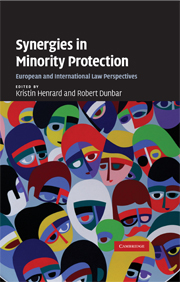Book contents
- Frontmatter
- Contents
- Foreword
- Abbreviations
- 1 Introduction
- PART A Minorities-specific instruments, provisions and institutions
- 2 The United Nations International Covenant on Civil and Political Rights: Article 27 and other provisions
- 3 The United Nations Working Group on Minorities
- 4 The OSCE High Commissioner on National Minorities
- 5 The Council of Europe's Framework Convention for the Protection of National Minorities
- 6 The Council of Europe's European Charter for Regional or Minority Languages
- PART B Non-minorities-specific instruments, provisions and institutions
- Index
- References
4 - The OSCE High Commissioner on National Minorities
from PART A - Minorities-specific instruments, provisions and institutions
Published online by Cambridge University Press: 21 July 2009
- Frontmatter
- Contents
- Foreword
- Abbreviations
- 1 Introduction
- PART A Minorities-specific instruments, provisions and institutions
- 2 The United Nations International Covenant on Civil and Political Rights: Article 27 and other provisions
- 3 The United Nations Working Group on Minorities
- 4 The OSCE High Commissioner on National Minorities
- 5 The Council of Europe's Framework Convention for the Protection of National Minorities
- 6 The Council of Europe's European Charter for Regional or Minority Languages
- PART B Non-minorities-specific instruments, provisions and institutions
- Index
- References
Summary
Introduction
Since the beginning of the 1990s, the institution of the OSCE High Commissioner on National Minorities (the ‘High Commissioner’) has acquired a considerable prestige in the area of conflict prevention. Even though the High Commissioner is primarily, or even exclusively, aiming at the prevention of conflicts relating to national minority issues, it is obvious that a major tool for the High Commissioner to achieve his aims is monitoring and promoting a proper implementation of minority rights. Nevertheless, the security-oriented perspective of the High Commissioner cannot be overlooked, as it implies that he is – according to his mandate at least – only active in minority situations where serious tensions exists. It also implies that, as a conflict prevention instrument, the High Commissioner only considers a limited number of minority problems, whereas other minority problems which ‘don't have the potential to develop into a conflict’ fall outside the scope of his mandate.
The purpose of this chapter is to consider how far the High Commissioner has contributed over the years to a further strengthening and development of minority rights standards. Did the activities of the High Commissioner indeed lead to the development of new standards, or did they contribute to a further elaboration or clarification of existing standards? In another study, the first author of this chapter has explored the High Commissioner's role in relation to citizenship issues and concluded that the High Commissioner in the 1990s indeed contributed considerably to developing certain criteria which he used to monitor developments within specific countries.
- Type
- Chapter
- Information
- Synergies in Minority ProtectionEuropean and International Law Perspectives, pp. 88 - 118Publisher: Cambridge University PressPrint publication year: 2009
References
- 1
- Cited by

